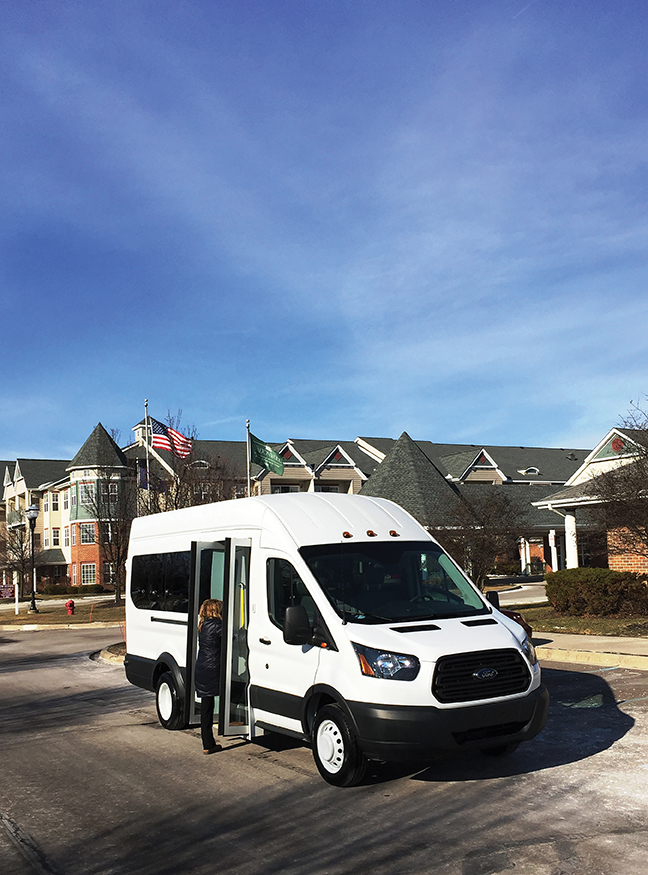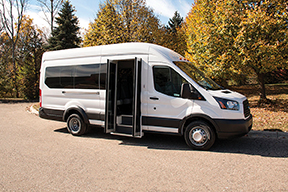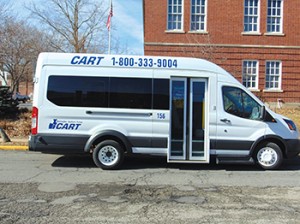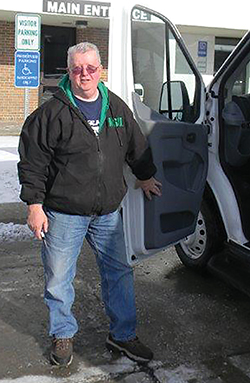
Ford Transit by Mobility Transportation Services
Three rural community transit agencies have already given this specially upfitted Transit their hearty approval
By David Hubbard
Dave Brown was working as a fleet manager for a Chevrolet dealership in 1981 when he saw a new market developing for vans equipped to transport passengers with disabilities. By 1992, shortly after the enactment of the Americans with Disabilities Act (ADA), he noticed a growing number of adult foster care homes buying specially-equipped vehicles. At this point, Brown and his wife, Geri, stepped out on their own to form Mobility Transportation Services, located in Canton, MI. True to form as a family company, their son, Nick, now leads the sales team.

“We started by providing vans for the Chevy Ride Share incentive program,” Brown says. “This concept was popular at the time in the Detroit area. Once it took off, we began providing vehicles to adult foster care agencies nationwide.”
Brown says the new company recorded 85 new bus sales in its first year. By 2000, Mobility Transportation was moving 500 vehicles per year, and has since become one of the nation’s largest volume bus dealers and small bus converters, specializing in conversions to paratransit, passenger and prisoner transport vans. Incorporating lean manufacturing techniques to insure quality while keeping costs competitive, Mobility Transportation Services has built more than 10,000 vehicles to date, delivering to customers in all 50 U.S. states and the territory of Guam.
Fast track to 2014, the year Ford introduced the European Transit van to the U.S. market, and Mobility Transportation quickly transitioned to conversions based on the new Transit chassis. The company built its first Transit vehicle with FMVSS safety-tested wheelchair tie downs and shoulder harnesses for display at APTA EXPO. That same year, Mobility Transportation Services and Nor-Cal Vans, Chico, CA, co-developed the Ford Transit incorporating the dual-leaf bus doorway by A&M Systems, Elkhart, IN, that replaces a standard sliding door. Mobility Transportation Services covers the Midwest and Eastern states, while Nor-Cal Vans builds and distributes Transit conversions west of the Colorado Rocky Mountain.
“We are currently building 80 units per month with upfits for standard transit, paratransit, airport shuttle and prisoner transport in 18, 20 and 22-foot lengths, as well as three different roof heights,” Brown says. “We can configure our vans and buses to carry as many as 17 passengers or accommodate up to five ADA wheelchair spaces.”
Brown says the Ford Transit blurs the line between a van and a bus, particularly the largest model weighing in at 10,300 gross vehicle weight rating (GVWR) with dual rear wheels. However, it is the entry and door system that defines this Ford Transit product, and what separates Mobility Transportation and Nor-Cal from other upfitters.
“The frame above the door is very strong Boron steel and Ford guidelines warn not to cut into this important structure,” Brown says. “Our design does not intrude into the structural Boron steel in any way. We laser-cut the steel for the door to precisely match the curve of the body, thereby eliminating edges where rust might start – ultimately giving a pleasing appearance.”

The entry steps into the bus are 9 inches deep, 9 inches high, with even tread. The electrically-operated digital control on the outside, LED foot lighting and stainless steel grab rails at both sides of the entrance are standard features.
The Official BUSRide Road Test
BUSRide met recently with Mobility Transportation Services for a review of its Ford Transit product. The Suburban Mobility Authority for Regional Transportation (SMART), Detroit, MI, also participated while awaiting delivery on its three Transit vans with the modified doorway. Again, Brown seems to have rooted out yet another niche market.
“We are finding that our upfit for the Ford Transit is especially attractive to transportation authorities that serve rural communities,” Brown says. “Several are using our buses primarily for Shared Ride programs and non-emergency medical transport for seniors in outlying areas.”
He says the advantages of the Ford Transit are fairly obvious.
“Our model is, first of all, a Ford product through and through,” he says. “We deliver this unibody Transit with our proprietary upfits with all factory warranties intact. A small agency can conveniently take this vehicle to any Ford dealership for service, repairs and warranty work, which is a tremendous benefit for rural operators.”
Ride SMART
The Suburban Mobility Authority for Regional Transportation, serving suburban metro Detroit, MI, operates in 76 communities in Wayne, Oakland and Macomb Counties, a region of approximately 1,200 square miles. In addition to standard transit services, the agency also provides its third tier “grass roots” Community Partnership Program, a rare instance where the larger centralized transit authority has essentially wed with smaller, decentralized agencies that are locally operated.
SMART worked four years with the Federal Transit Administration (FTA) to develop this program, which it implemented in 1995, and says it is most likely the first transit authority in the country to initiate such a program to assist individual communities with their transit operations.
“Transit service in each community is somewhat different than that of its neighbors, as the needs of the residents differ significantly from one community to the next,” says SMART Communications Director Beth Gibbons. “Each community determines its specific transit services and the necessary equipment.”
“Our role is to provide administrative support for all the communities,” says Frederic J. Barbret, SMART ombudsman for Macomb County. “This includes the initial funding for buses, maintenance, technical and operational services for their choice of services. Rather than one community using its funds to buy one or two vans, we make volume purchases and distribute the requested number of buses to each community at a much better price.”
SMART holds the titles to the vehicles and handles all
maintenance responsibilities.

“The communities rely on our experience, expertise, facility and resources to their vehicles,” says SMART Director of Maintenance Operations Keith Taylor. “If any work is performed outside the SMART facility, it is still entered on the SMART record to meet all federal and state requirements.”
Taylor says the new Ford Transits with the bus door are ideal for transit service in these smaller, more rural communities.
“For the most part, their buses transport only a few people at a time,” he says. “They don’t want or need larger buses, and these buses do not necessitate drivers having a commercial driver license (CDL).”
Robert Nieman stepped up to test drive the bus and offer his third-party review. Typical of the many drivers in this program, Nieman is retired and drives part time for SMART in the East Point and Roseville communities, taking seniors to their medical appointments and grocery shopping.
“The Community Partnership allows SMART to hire people just like Bob,” Barbret says. “As members of their community, they can drive their neighbors around a couple days a week as a way of giving back. We see our new Transit buses creating a nice bond between this service and the people who rely on the bus.”
Niemen seemed sold on the Transit before he even started the engine and left the parking lot.
“I see right now, this bus is going to make my job much easier,” he says. “Just sitting in the driver’s seat, the steering wheel, dashboard and controls are much more comfortable than the bus I usually drive.”
Niemen chose a route through several communities, out on the expressway, and turning into the tight drives and parking lots where he typically meets and drops off passengers.
“This bus handles as easily as a conventional vehicle,” he says. “I especially like the bus door. It makes all the difference in how I can greet and serve my passengers.”
Ki Bois Area Transit
Similarly, Ki Bois Area Transit System (KATS), Poteau, OK, operates a fleet of 250 buses from 18 offices throughout 13 counties in rural Oklahoma, transporting senior citizens to and from appointments, shopping and outings, and recently took delivery of three Ford Transits from Mobility Transportation.
“With offices as far as 75 miles from our maintenance hub, we like the fact that is a Ford product,” says Ron Davis, KATS safety and maintenance supervisor. “We typically see our vehicles once every 15,000 miles, so we rely heavily on warranty work through the dealerships.”
Ki Bois operates along the Arkansas border and makes runs into Fort Smith for medical appointments. As DOT stipulates a CDL driver for any commercial vehicle over 10,000 GVWR, Davis says KATS ordered its eight-passenger Transits at just under 9,200 GVWR.
“Getting around the CDL requirement with these Transits is a big one for us,” Davis says. “It is getting harder and harder to find qualified drivers who can pass the physical. With these buses, we can hire safe and dependable drivers with all the credentials. This is why we started thinking about Mobility Transportation. We now have these buses in service and we’re hearing no complaints. Our drivers think they are fantastic.”
Huntingdon Transit
The Huntingdon Bedford Fullerton Area Agency on Aging (HBFAAA), Bedford, PA, operates its demand-response Shared Ride and Medical Assistance Transportation programs for seniors and passengers with disabilities. The agency uses 45 vehicles to serve customers living as far as 35 miles from the agency’s hub in the county seat of Bedford, and recently placed six Ford Transit buses from Mobility Transportation into service.
“This 50,000 square-mile region of southern Pennsylvania is very rural and sparsely populated,” says Administrator Officer Mike Whysong. “Our new Transits will make the longer rides much more comfortable for our drivers and our passengers. The entry door is a very nice addition, and I especially like the lower entry step to make boarding and unboarding easier and safer for our elderly customers.”
Whysong says drivers have been very complimentary of the new Transit buses, as well as customers riding them for the first time.
“They are commenting on the comfort and great visibility, as well as the overall smoother ride,” he says. “But specifically, everyone likes the entry door.”
From all reports, agencies seem to appreciate passengers being able to move easily on and off the bus aided by the ample width of the entry and lower step.
“As more and more agencies take a look at the new Ford Transit, we expect 2016 to be very busy” Brown says. “It fits the needs of demand-response and rural transit in the most efficient manner available.”
